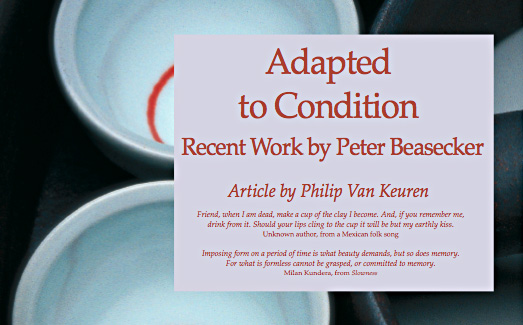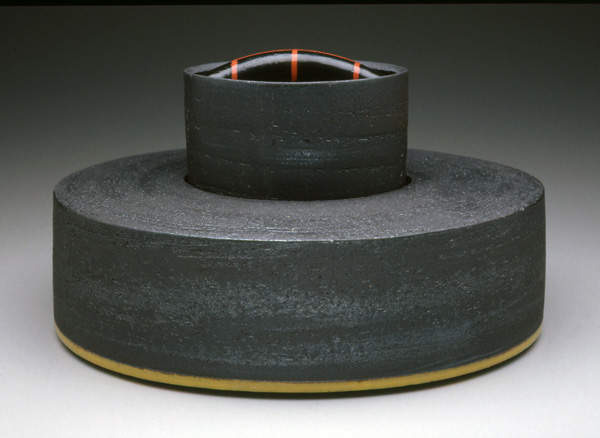Adapted to Condition by Philip Van Keuren
This article was originally published in the 2004 issue of Ceramic Art & Perception, issue 55, pages 3-7.
 IN THOMAS HART BENTON, A 1988 FILM BY KEN BURNS, Benton’s sister Mildred Small is reminiscing on her brother’s life and art when she rather unexpectedly announces, There aren’t any real New Yorkers. They all came from the Middle West. But that’s not strictly true but it’s amazing. There is a great deal of force in the Middle West. It is the US. The shores are the borders. Things go on in a lively fashion in San Francisco and New York City, but they aren’t the US. It is a remarkably frank thing to say, and its populist-regionalist tone goes a long way in addressing the recent works of Peter Beasecker. Born and raised in Toledo, Ohio, Beasecker’s recent work seems indebted to the values, communal histories and familial social bonds of the Midwest in ways that are only now becoming more clear. Returning often to the place of his birth and maintaining close family relationships are as much a part of his work as the proportions he arrives at slowly and with great care or the restrained and simple use of colour.
IN THOMAS HART BENTON, A 1988 FILM BY KEN BURNS, Benton’s sister Mildred Small is reminiscing on her brother’s life and art when she rather unexpectedly announces, There aren’t any real New Yorkers. They all came from the Middle West. But that’s not strictly true but it’s amazing. There is a great deal of force in the Middle West. It is the US. The shores are the borders. Things go on in a lively fashion in San Francisco and New York City, but they aren’t the US. It is a remarkably frank thing to say, and its populist-regionalist tone goes a long way in addressing the recent works of Peter Beasecker. Born and raised in Toledo, Ohio, Beasecker’s recent work seems indebted to the values, communal histories and familial social bonds of the Midwest in ways that are only now becoming more clear. Returning often to the place of his birth and maintaining close family relationships are as much a part of his work as the proportions he arrives at slowly and with great care or the restrained and simple use of colour.
His works are made to be used but possess a purity of form that transcends mere utility. They are common objects of uncommon grace. In Beasecker’s words, These pieces represent a combination of things seen and felt in my travels. Beasecker has a keen eye for the shape of things and the relationship of parts to one another and to the whole. He often begins the process by making multiple asphalt-impregnated roofing-felt models or prototypes to help refine and define the relationships of one part, or one form, to another. Held together by paperclips, this pattern making allows Beasecker yet another avenue to search for the right combinations of line, form, proportion, and even shadow. That design sensibility seems imbued with a strong sense of the value, responsibilities and importance of the communal experience. Sharing, fairness, harmony, cooperation, placing the needs of the group above individual self-interest, life centred on the family all play a critical role in his life and in the way his well-made and functional work looks and, more importantly, behaves.

Basket Carrier. 2002. Stoneware, porcelain cups (9). 49 x 38 x 18 cm.
The works are perhaps best described by their titles: Wedding Carrier, Double Carrier, Round Carrier, Basket Carrier, Lidded Carrier and Oval Carrier. Even in a form that is as familiar as the word “carrier” suggests, Beasecker brings a wide variety of original shapes into play. As the word implies, a carrier is a thing of use, of utilitarian value. The “value” implied in carriers such as these, with multiple cups within, is that they “behave” communally. They are meant to be used by many gathered together in a communal ritual almost certainly acted out in a small duration of time. Even when not in use (which is most of the time), the carriers still actively, one could say even joyously, announce their communal intentions. Many models exist for thinking about works that spring from the mastery of a craft through the use of tools, materials and processes welded to a largely agrarian lifestyle centred on the family. One in particular seems especially relevant to Beasecker’s work in multiple ways and bears closer scrutiny.
The United Society of Believers, or Shakers as they are better known, had between 4000 to 6000 members by 1840. Begun in 1774, Shaker communities grew to number 24, mostly centred in New England and the Midwest. New York had four, and Massachusetts led with five. Shakerism flourished in Ohio with Union Village (1806-1912), North Union (1822-1889), Whitewater (1824-1907) and Watervilet (1806-1910). Shakers only rarely invented new forms. Their real talent lay in refining existing forms along with an eye for harmony of proportion and a keen understanding of the qualities and characteristics of their chosen materials. Materials always fit the demands of use in a Shaker-made object. For Shakers a handle added to an oval box resulted in a wholly new form, the carrier. Even then Shaker ingenuity led to fixed and swing-handled versions in a seemingly endless array of sizes, shapes and colours. Viewed by many as perhaps the penultimate Shaker form, the oval box was itself a highly refined design solution patterned after much earlier oval box forms found throughout colonial America. In turn, those earliest American oval boxes had their roots in now archaic European oval box forms.

Capped Carrier. 2002. Stoneware, porcelain cups (10). 38 x 30 x 30 cm.
Correspondence between philosophical values and Beasecker’s artisanship results in the penetration of those ideals into what is for him the secular studio activity of making utilitarian articles. Certainly Beasecker’s well ordered and balanced carriers are individualistic creative expressions and not collective ones but the principles remain the same. Originality and invention appear not as fashion or merely “aesthetic” phenomenon but as evidence of beliefs for Beasecker. If the utilitarian design principle applies, then innovation possibilities lie mostly in the refinement of previously discovered solutions to needs and the uses attached to those needs. Utility alone does not curve a wall or shape a handle. It only suggests those necessities are practical solutions to better use. Perhaps all makers of utilitarian objects of simple materials are linked to Shaker belief and custom in ways only they can understand. To be sure, beauty for Beasecker at least partially rests on util- ity, and beauty does matter to him. While his carriers are based on traditional forms and techniques, personal and individual aesthetic visions determine the way those forms appear. The works also look the way they do, and behave the way they do, for “useful” reasons, and it is essential to him that they be used and that they behave, function if you will, in a way that is commensurate with their use. This is an important distinction for Beasecker and cannot be separated from the way something appears.

Wedding Carrier. 2002. Stoneware, porcelain cups (8). 61 x 18 x 13 cm.
 Double Carrier. 2001. Stoneware, porcelain cups (10). Wood handle. 51 x 20 x 13 cm.
Double Carrier. 2001. Stoneware, porcelain cups (10). Wood handle. 51 x 20 x 13 cm.
This is about as close to the Shaker theory of making things as one can get. In a timeless 1939 book review of Shaker Furniture: The Craftsmanship of an American Faith Andrews. Ananda K. Coomaraswamy (1877-1947) argued that things are only beautiful in the environment for which they were designed, or as the Shaker expressed it when adapted to condition. Shaker style was not a “fashion” determined by taste, but rather a creative activity adapted to condition. Coomaraswamy goes on to say: To imitate Shaker works would be no proof of a creative virtue in ourselves: their austerity, imitated for our convenience, economic or aesthetic, becomes a luxury in us: their avoidance of ornament an interior decoration for us. Most importantly near the end of his review he suggests that “if we were now such as the Shaker was, an art of our own, adapted to condition, would be indeed essentially like, but assuredly accidentally unlike Shaker art.”
Coomaraswamy was right to say, “All archaism is the proof of a deficiency.” The world is seemingly awash in secular activity devoid of any spirit. Mindless and meaningless reproduction and rehashing of ideas unrelated to any real life experiences are the norm. Perhaps that is why Beasecker’s ordinary carriers are so extraordinary. He has managed to bring his way of work and his way of life into a kind of delicate balance. Long periods of solitude in his studio quietly working his way through variation after variation, yields work that reflects not only his devotion to his art but his understanding of his place in the world. It is surely not only the domain of Midwesterners, as Mildred Small suggested, but the roots are still somehow embedded in those Ohioan, communal, agrarian histories of people and the things they made, used, and often cherished for generations. In The Poetics of Space, Gaston Bachelard quotes Pierre-Jean Jouve: “Poetry is a soul inaugurating a form.” Bachelard responds, “The soul inaugurates. Here it is the supreme power. It is human dignity. Even if the (form) was already well-known, previously discovered, carved from commonplaces, before the interior poetic light was turned upon it, it was a mere object for the mind. But the soul comes and inaugurates the form, dwells in it, takes pleasure in it.” The Shaker phrase “adapted to condition” might be just another way to say the same thing about Peter Beasecker’s art.